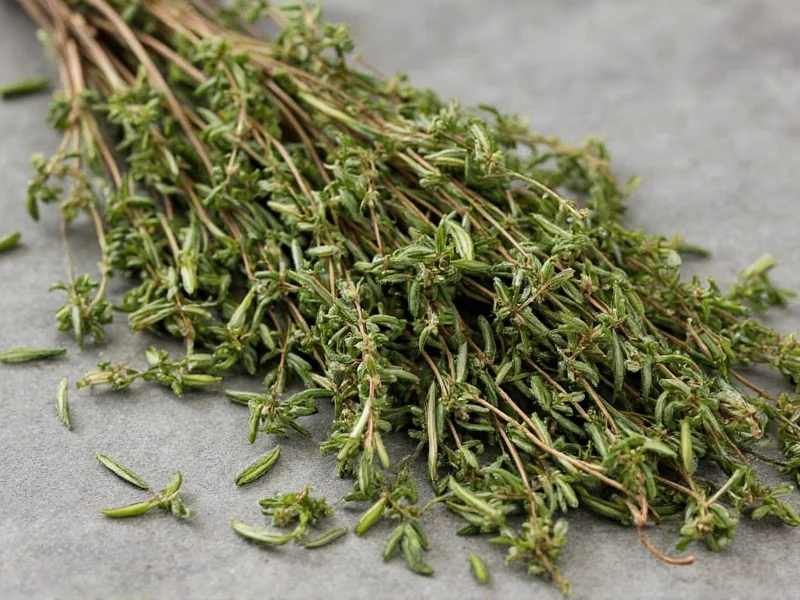Understanding dried thyme to fresh conversion prevents recipe failures and ensures balanced flavor in your culinary creations. When substituting between these two forms, the key factor is potency—drying concentrates thyme's essential oils, making dried thyme significantly stronger than fresh. This fundamental principle drives the universal 1:3 substitution ratio used by professional chefs and home cooks alike.
Why Dried and Fresh Thyme Require Conversion
Thyme undergoes significant chemical changes during the drying process. As moisture evaporates, the herb's essential oils and flavor compounds become more concentrated. Fresh thyme contains approximately 85% water content, while dried thyme reduces to about 10-15% moisture. This dramatic water loss explains why you need three times the volume of fresh thyme to match the flavor impact of dried thyme.
Attempting to use equal measurements creates imbalanced dishes—too much dried thyme results in overpowering, bitter flavors, while insufficient fresh thyme leaves dishes lacking aromatic complexity. Mastering this dried thyme to fresh conversion ratio transforms your cooking precision and recipe reliability.
Detailed Thyme Conversion Chart
| Dried Thyme | Fresh Thyme Equivalent | Common Recipe Application |
|---|---|---|
| ¼ teaspoon | ¾ teaspoon | Salad dressings, light sauces |
| ½ teaspoon | 1½ teaspoons | Vegetable dishes, omelets |
| 1 teaspoon | 1 tablespoon | Standard conversion ratio |
| 1½ teaspoons | 4½ teaspoons | Stews, braises |
| 1 tablespoon | 3 tablespoons | Large batch recipes, roasts |
Practical Conversion Examples for Home Cooking
Consider these real kitchen scenarios when applying dried thyme to fresh conversion:
- Tomato sauce recipe calling for 1 teaspoon dried thyme: Use 1 tablespoon fresh thyme leaves (stripped from stems). Add fresh thyme during the last 10 minutes of cooking to preserve delicate flavor compounds.
- Roast chicken requiring 2 teaspoons dried thyme: Substitute with 2 tablespoons fresh thyme. For optimal flavor distribution, mix fresh thyme with softened butter before rubbing under poultry skin.
- Bean soup specifying 1½ teaspoons dried thyme: Use 4½ teaspoons fresh thyme. Add fresh thyme at the beginning of cooking since soups benefit from longer simmering to develop flavor.
Factors Affecting Thyme Potency and Conversion Accuracy
Several variables influence the precise dried thyme to fresh conversion in your kitchen:
Storage conditions: Dried thyme loses potency over time. Properly stored in an airtight container away from light, dried thyme maintains peak flavor for 1-2 years. Older dried thyme may require slightly increased measurements when substituting.
Thyme variety: Common garden thyme (Thymus vulgaris) follows the standard 1:3 ratio. However, lemon thyme or other specialty varieties may have different concentration levels due to varying essential oil compositions.
Measurement technique: How you measure affects outcomes. For dried thyme, spoon gently into measuring spoons without packing. For fresh thyme, strip leaves from stems before measuring to avoid counting woody stems in your volume.
When to Adjust the Standard Conversion Ratio
While the 1:3 dried thyme to fresh conversion serves as your reliable baseline, certain situations warrant adjustments:
- Delicate dishes: For subtle preparations like fish or custards, use a 1:2.5 ratio to prevent thyme from dominating other flavors.
- Long-cooking recipes: In dishes simmering over 2 hours, fresh thyme's flavor diminishes. Consider using a 1:3.5 ratio to maintain consistent herb presence throughout cooking.
- Personal preference: If you prefer more pronounced herbal notes, gradually increase fresh thyme by ¼ teaspoon increments until achieving desired flavor profile.
Common Substitution Mistakes to Avoid
Many home cooks make critical errors when converting between dried and fresh thyme:
- Ignoring timing: Adding fresh thyme at the same stage as dried thyme results in diminished flavor. Fresh herbs generally require later addition to preserve volatile compounds.
- Measuring with stems: Counting fresh thyme stems as part of the measurement significantly reduces actual herb content. Always remove leaves from woody stems before measuring.
- Assuming uniform potency: Not all dried thyme maintains equal strength. Older dried thyme may require slightly increased measurements compared to freshly dried product.
Maximizing Flavor in Thyme Substitutions
For optimal results when substituting fresh for dried thyme, follow these professional techniques:
Crush fresh thyme leaves gently between your fingers before adding to release essential oils. This simple action increases flavor dispersion by approximately 30% compared to adding whole leaves. When substituting dried for fresh, bloom the dried thyme in warm oil or broth for 2-3 minutes before incorporating into your dish—this rehydrates the herb and enhances flavor release.
Remember that fresh thyme offers brighter, more complex flavor notes with subtle citrus undertones that dried thyme cannot replicate. While the 1:3 conversion ensures proper potency, understanding these flavor differences helps you make informed decisions about when substitution works best versus seeking the specifically called-for form.











 浙公网安备
33010002000092号
浙公网安备
33010002000092号 浙B2-20120091-4
浙B2-20120091-4